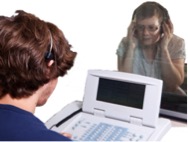Hearing Loss in Children
Content
What is Hearing Loss?
Signs and Symptoms
Screening and Diagnosis
Treatments and Intervention Services
Early Intervention and Special Education
Technology
Medical and Surgical
Causes and Risk Factors
Prevention
Get Help!
Hearing loss can affect a child’s ability to develop communication, language, and social skills. The earlier children with hearing loss start getting services, the more likely they are to reach their full potential. If you are a parent and you suspect your child has hearing loss, trust your instincts and speak with your child’s doctor. Don’t wait!
What is Hearing Loss?
A hearing loss can happen when any part of the ear is not working in the usual way. This includes the outer ear, middle ear, inner ear, hearing (acoustic) nerve, and auditory system.
Signs and Symptoms
The signs and symptoms of hearing loss are different for each child. If you think that your child might have hearing loss, ask the child’s doctor for a hearing screening as soon as possible. Don’t wait!
Even if a child has passed a hearing screening before, it is important to look out for the following signs.
Signs in Babies
· Does not startle at loud noises.
· Does not turn to the source of a sound after 6 months of age.
· Does not say single words, such as “dada” or “mama” by 1 year of age.
· Turns head when he or she sees you but not if you only call out his or her name. This sometimes is mistaken for not paying attention or just ignoring, but could be the result of a partial or complete hearing loss.
· Seems to hear some sounds but not others.
Signs in Children
· Speech is delayed.
· Speech is not clear.
· Does not follow directions. This sometimes is mistaken for not paying attention or just ignoring, but could be the result of a partial or complete hearing loss.
· Often says, “Huh?”
· Turns the TV volume up too high.
Babies and children should reach milestones in how they play, learn, communicate and act. A delay in any of these milestones could be a sign of hearing loss or other developmental problem.
Screening and Diagnosis
Hearing Screening
Hearing screening is a test to tell if people might have hearing loss. Hearing screening is easy and not painful. In fact, babies are often asleep while being screened. It takes a very short time — usually only a few minutes.
Babies
· All babies should be screened for hearing loss no later than 1 month of age. It is best if they are screened before leaving the hospital after birth.
· If a baby does not pass a hearing screening, it's very important to get a full hearing test as soon as possible, but no later than 3 months of age.
Older Babies and Children
· If you think a child might have hearing loss, ask the doctor for a hearing screening as soon as possible.
· Children who are at risk for acquired, progressive, or delayed-onset hearing loss should have at least one hearing test by 2 to 2 1/2 years of age. Hearing loss that gets worse over time is known as acquired or progressive hearing loss. Hearing loss that develops after the baby is born is called delayed-onset hearing loss. Find out if a child may be at risk for hearing loss.
· If a child does not pass a hearing screening, it's very important to get a full hearing test as soon as possible.
Full Hearing Test
All children who do not pass a hearing screening should have a full hearing test. This test is also called an audiology evaluation. An audiologist, who is an expert trained to test hearing, will do the full hearing test. In addition, the audiologist will also ask questions about birth history, ear infection and hearing loss in the family.
There are many kinds of tests an audiologist can do to find out if a person has a hearing loss, how much of a hearing loss there is, and what type it is. The hearing tests are easy and not painful.
Some of the tests the audiologist might use include:
Auditory Brainstem Response (ABR) Test or Brainstem Auditory Evoked Response (BAER) Test
Auditory Brainstem Response (ABR) or Brainstem Auditory Evoked Response (BAER) is a test that checks the brain's response to sound. Because this test does not rely on a person’s response behavior, the person being tested can be sound asleep during the test.

Otoacoustic Emissions (OAE)
Otoacoustic Emissions (OAE) is a test that checks the inner ear response to sound. Because this test does not rely on a person’s response behavior, the person being tested can be sound asleep during the test.
Behavioral Audiometry Evaluation
Behavioral Audiometry Evaluation will test how a person responds to sound overall. Behavioral Audiometry Evaluation tests the function of all parts of the ear. The person being tested must be awake and actively respond to sounds heard during the test.
With the parents’ permission, the audiologist will share the results with the child’s primary care doctor and other experts, such as:
· An ear, nose and throat doctor, also called an otolaryngologist
· An eye doctor, also called an ophthalmologist
· A professional trained in genetics, also called a clinical geneticist or a genetics counselor

Treatments and Intervention Services
No single treatment or intervention is the answer for every child or family. Good intervention plans will include close monitoring, follow-ups and any changes needed along the way. There are many different options for children with hearing loss and their families.
Some of the treatment and intervention options include:
· Working with a professional (or team) who can help a child and family learn to communicate.
· Getting a hearing device, such as a hearing aid.
· Joining support groups.
· Taking advantage of other resources available to children with a hearing loss and their families.
Early Intervention and Special Education
Early Intervention (0-3 years)
Hearing loss can affect a child’s ability to develop speech, language, and social skills. The earlier a child who is deaf or hard-of-hearing starts getting services, the more likely the child’s speech, language, and social skills will reach their full potential.
Early intervention program services help young children with hearing loss learn language skills and other important skills. Research shows that early intervention services can greatly improve a child’s development.
Babies that are diagnosed with hearing loss should begin to get intervention services as soon as possible, but no later than 6 months of age.
There are many services available through the Individuals with Disabilities Education Improvement Act 2004 (IDEA 2004). Services for children from birth through 36 months of age are called Early Intervention or Part C services. Even if your child has not been diagnosed with a hearing loss, he or she may be eligible for early intervention treatment services. The IDEA 2004 says that children under the age of 3 years (36 months) who are at risk of having developmental delays may be eligible for services. These services are provided through an early intervention system in your state. Through this system, you can ask for an evaluation.
Special Education (3-22 years)
Special education is instruction specifically designed to address the educational and related developmental needs of older children with disabilities, or those who are experiencing developmental delays. Services for these children are provided through the public school system. These services are available through the Individuals with Disabilities Education Improvement Act 2004 (IDEA 2004), Part B.
Early Hearing Detection and Intervention (EHDI) Program
Every state has an Early Hearing Detection and Intervention (EHDI) program. EHDI works to identify infants and children with hearing loss. EHDI also promotes timely follow-up testing and services or interventions for any family whose child has a hearing loss.
Technology
Many people who are deaf or hard-of-hearing have some hearing. The amount of hearing a deaf or hard-of-hearing person has is called "residual hearing". Technology does not "cure" hearing loss, but may help a child with hearing loss to make the most of their residual hearing. For those parents who choose to have their child use technology, there are many options, including:
· Hearing aids
· Cochlear implants
· Bone-anchored hearing aids
· Other assistive devices
Hearing Aids

Hearing aids make sounds louder. They can be worn by people of any age, including infants. Babies with hearing loss may understand sounds better using hearing aids. This may give them the chance to learn speech skills at a young age.
There are many styles of hearing aids. They can help many types of hearing losses. A young child is usually fitted with behind-the-ear style hearing aids because they are better suited to growing ears.
Cochlear Implants
A cochlear implant may help many children with severe to profound hearing loss — even very young children. It gives that child a way to hear when a hearing aid is not enough. Unlike a hearing aid, cochlear implants do not make sounds louder. A cochlear implant sends sound signals directly to the hearing nerve.
A cochlear implant has two main parts — the parts that are placed inside the ear during surgery, and the parts that are worn outside the ear after surgery. The parts outside the ear send sounds to the parts inside the ear.
CDC and the Food and Drug Administration (FDA) carried out studies in 2002 and 2006 to learn more about a possible link between cochlear implants and bacterial meningitis in children with cochlear implants. Read about the bacterial meningitis studies »
Bone-Anchored Hearing Aids
This type of hearing aid can be considered when a child has either a conductive, mixed or unilateral hearing loss and is specifically suitable for children who cannot otherwise wear 'in the ear' or 'behind the ear' hearing aids.
Other Assistive Devices
Besides hearing aids, there are other devices that help people with hearing loss. Following are some examples of other assistive devices:
· FM System
An FM system is a kind of device that helps people with hearing loss hear in background noise. FM stands for frequency modulation. It is the same type of signal used for radios. FM systems send sound from a microphone used by someone speaking to a person wearing the receiver. This system is sometimes used with hearing aids. An extra piece is attached to the hearing aid that works with the FM system.
· Captioning
Many television programs, videos, and DVDs are captioned. Television sets made after 1993 are made to show the captioning. You don't have to buy anything special. Captions show the conversation spoken in soundtrack of a program on the bottom of the television screen.
· Other devices
There are many other devices available for children with hearing loss. Some of these include:
o Text messaging
o Telephone amplifiers
o Flashing and vibrating alarms
o Audio loop systems
o Infrared listening devices
o Portable sound amplifiers
o TTY (Text Telephone or teletypewriter)
Medical and Surgical
Medications or surgery may also help make the most of a person’s hearing. This is especially true for a conductive hearing loss, or one that involves a part of the outer or middle ear that is not working in the usual way.

One type of conductive hearing loss can be caused by a chronic ear infection. A chronic ear infection is a build-up of fluid behind the eardrum in the middle ear space. Most ear infections are managed with medication or careful monitoring. Infections that don't go away with medication can be treated with a simple surgery that involves putting a tiny tube into the eardrum to drain the fluid out.
Another type of conductive hearing loss is caused by either the outer and or middle ear not forming correctly while the baby was growing in the mother's womb. Both the outer and middle ear need to work together in order for sound to be sent correctly to the inner ear. If any of these parts did not form correctly, there might be a hearing loss in that ear. This problem may be improved and perhaps even corrected with surgery. An ear, nose, and throat doctor (otolaryngologist) is the health care professional who usually takes care of this problem.
Placing a cochlear implant or bone-anchored hearing aid will also require a surgery.
Learning Language
Without extra help, children with hearing loss have problems learning language. These children can then be at risk for other delays. Families who have children with hearing loss often need to change their communication habits or learn special skills (such as sign language) to help their children learn language. These skills can be used together with hearing aids, cochlear implants, and other devices that help children hear.
Causes and Risk Factors
Hearing loss can happen any time during life – from before birth to adulthood.
Following are some of the things that can increase the chance that a child will have hearing loss:
· A genetic cause: About 1 out of 2 cases of hearing loss in babies is due to genetic causes. Some babies with a genetic cause for their hearing loss might have family members who also have a hearing loss. About 1 out of 3 babies with genetic hearing loss have a “syndrome.” This means they have other conditions in addition to the hearing loss, such as Down syndrome or Usher syndrome. Learn more about the genetics of hearing loss »
· 1 out of 4 cases of hearing loss in babies is due to maternal infections during pregnancy, complications after birth, and head trauma. For example, the child:
o Was exposed to infection, such as cytomegalovirus (CMV) infection, before birth
o Spent 5 days or more in a hospital neonatal intensive care unit (NICU) or had complications while in the NICU
o Needed a special procedure like a blood transfusion to treat bad jaundice
o Has head, face or ears shaped or formed in a different way than usual
o Has a condition like a neurological disorder that may be associated with hearing loss
o Had an infection around the brain and spinal cord called meningitis
o Received a bad injury to the head that required a hospital stay
· For about 1 out of 4 babies born with hearing loss, the cause is unknown.
Prevention
Following are tips for parents to help prevent hearing loss in their children:
· Have a healthy pregnancy.
· Learn how to prevent cytomegalovirus (CMV) infection during pregnancy.
· Make sure your child gets all the regular childhood vaccines.
· Keep your child away from high noise levels, such as from very loud toys. Visit the National Institutes of Health’s website to learn more about preventing noise-induced hearing loss.
Get Help!
· If you think that your child might have hearing loss, ask the child’s doctor for a hearing screening as soon as possible. Don’t wait!
· If your child does not pass a hearing screening, ask the child’s doctor for a full hearing test as soon as possible.
· If your child has hearing loss, talk to the child’s doctor about treatment and intervention services.
Hearing loss can affect a child’s ability to develop speech, language, and social skills. The earlier children with hearing loss start getting services, the more likely they are to reach their full potential. If you are a parent and you suspect your child has hearing loss, trust your instincts and speak with your child’s doctor.

